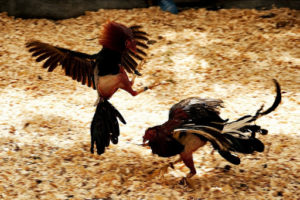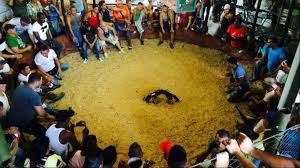 PELEAS DE GALLOS EN CUBA Y ALREDEDOR DEL MUNDO.
PELEAS DE GALLOS EN CUBA Y ALREDEDOR DEL MUNDO.
Una pelea de gallos es un deporte de sangre entre dos gallos, o gallos de pelea, que se celebra en un espacio circular o ring que en el argot gallistico se le llama valla de gallos.
La historia de la cría de aves para la lucha se remonta a 6,000 años. El primer uso documentado de la palabra gamecock, que denota el uso del gallo como un “juego”, un deporte, pasatiempo o entretenimiento, se registró en 1634, después del término “gallo del juego” utilizado por George Wilson, en los primeros tiempos. libro conocido sobre el deporte de las peleas de gallos en The Commendation of Cocks and Cock Fighting in 1607. Pero fue durante el viaje de descubrimiento de Filipinas de Magellan en 1521 cuando Antonio Pigafetta, cronista de Magellan, presenció y documentó por primera vez las peleas de gallos modernas. Taytay
En algunas zonas del mundo, las peleas de gallos todavía se practican como un evento principal; en algunos países, está regulado por ley o prohibido por completo. Los defensores del “deporte antiguo” a menudo mencionan la relevancia cultural y religiosa como razones para perpetuar las peleas de gallos como deporte.
Las vallas y las peleas de gallos en Cuba no son cosas de hace 60 años, los galleros tienen una tradición de más de 200 años en la Isla. En el siglo XIX era normal los domingos asistir a la valla de gallos. La estructura era circular, de dos pisos, construida en madera de manera muy sencilla y albergaba unas mil personas. El espectáculo comenzaba en la mañana y duraba hasta que hubiese gallos para luchar o gente apostando.
Hoy las peleas de gallos se ven favorecidas en todo el Caribe y en Cuba su popularidad está creciendo.
Después de la revolución de 1959, Cuba tomó medidas enérgicas contra las peleas de gallos como parte de la prohibición de los juegos de azar. Con los años esa postura se ha suavizado. Las arenas oficiales se han abierto y las arenas ocultas se toleran siempre que no haya broncas.
“La gente dice: si al gobierno se le permite celebrar peleas de gallos, ¿por qué no podemos?” dice Nora García Pérez, directora de la asociación cubana de bienestar animal Aniplant.
Los entusiastas sostienen que las peleas de gallos son una tradición centenaria. Los críticos dicen que es cruel, y culpan de su popularidad a la falta de opciones de entretenimiento, la educación deficiente sobre el bienestar animal y su potencial para ganar dinero.
En 2016, Ciego de Ávila, provincia de Camagüey, en Cuba, abrió su primer estadio oficial de peleas de gallos con 1,000 asientos, el más grande de Cuba, para consternación de los activistas de derechos de los animales que lo ven como un paso atrás.
Las peleas de gallos son un deporte de sangre debido al daño que los gallos se hacen mutuamente en las carlingas, exacerbado por espuelas de metal que se pueden unir a las espuelas de las aves.
En Ciego de Ávila, hay una arena clandestina diferente para cada día de la semana, algunas escondidas entre matorrales de marabú o en campos de caña de azúcar, por senderos de tierra sin señales. Las personas que llevan gallos en cabestrillos o debajo de los brazos viajan a estos lugares en carruajes tirados por caballos, en bicicleta o en autos americanos antiguos de color caramelo.
Las arenas hechas de madera y hojas de palma operan como parques de atracciones. Se venden sonidos de música ranchera de altavoces, carne de cerdo asada y ron, y se colocan mesas con dados y juegos de cartas.
“Verán lo divertido que es esto”, dice Yaidelin Rodríguez, de 32 años, habitual de su esposo, escribiendo en las libretas de apuestas que ha colocado en su polla.
Los juegos de azar están prohibidos en Cuba, pero fajos de cambio de efectivo en la mayoría de las arenas. Los entusiastas usan gorras de béisbol que dicen “Los gallos me ganan dinero, las mujeres me lo quitan”.
En la arena oficial de Ciego de Ávila, los extranjeros pagan hasta $60 por un asiento de primera fila. En las arenas ocultas, principalmente un asunto local, los asientos cuestan entre $2 y $8, una suma principesca en un país donde el salario promedio mensual del estado es de $25. “Podemos ganar alrededor de $600 por día con las tarifas de entrada y la venta de asientos”, dice Reinol, quien se negó a dar su nombre completo.
Cuba también exporta gallos, dicen los criadores, y agrega que los gallos con proezas de combate probadas podrían venderse por hasta $1000.
En una arena apartada cerca de Ciego de Ávila, una tarde reciente, los propietarios que fumaban cigarros y bebían ron vigilaban a sus pájaros para asegurarse de que nadie los hiriera o los envenenara antes de la pelea. “Vamos”, “adelante”, los espectadores gritaron una vez que comenzó, los gallos volando entre ellos con rabia.
“Hay que entrenar a los gallos como si fueran boxeadores, por lo que están preparados”, dice Basilio Gonzalesm, y agrega que también deben ser arreglados, con las piernas escarlatas cortadas y recortadas con plumas.
Algunos, como el fanatico de las peleas de gallos, Jorge Guerra, sueñan con ganar más dinero en países donde las apuestas son legales. “Me gustaría ir a algún lugar con grandes competencias y apuestas como Puerto Rico”, dijo el agricultor. “Me gustaría mostrarle a alguien cuánto dinero podría ganar para ellos criando gallos” termina diciendo.
 COCKFIGHTING IN CUBA AND THROUGHOUT THE WORLD.
COCKFIGHTING IN CUBA AND THROUGHOUT THE WORLD.
A cockfight is a blood sport between two cocks, or gamecocks, held in a ring called a cockpit.
The history of raising fowl for fighting goes back 6,000 years. The first documented use of the word gamecock, denoting use of the cock as to a “game”, a sport, pastime or entertainment, was recorded in 1634, after the term “cock of the game” used by George Wilson, in the earliest known book on the sport of cockfighting in The Commendation of Cocks and Cock Fighting in 1607. But it was during Magellan’s voyage of discovery of the Philippines in 1521 when modern cockfighting was first witnessed and documented by Antonio Pigafetta, Magellan’s chronicler, in the kingdom of Taytay.
In some areas around the world, cockfighting is still practiced as a mainstream event; in some countries, it is regulated by law, or forbidden outright. Advocates of the “age-old sport” often list cultural and religious relevance as reasons for the perpetuation of cockfighting as a sport.
The Rings (Vallas) and cockfights in Cuba are not things from 60 years ago, the galleros have a tradition of more than 200 years on the island. In the 19th century, it was normal on Sundays to attend the fence of roosters. The structure was circular, two-story, made of wood in a very simple way and housed about a thousand people. The show started in the morning and lasted until there were roosters to fight or people betting.
Today cockfighting is favored throughout the Caribbean and in Cuba its popularity is growing.
After the 1959 revolution, Cuba cracked down on cockfighting as part of a ban on gambling, recalls Ferrel. Over the years that stance has softened. Official arenas have opened and hidden arenas are tolerated as long as there are no brawls.
“‘People say: if the government is allowed to hold cockfights, why can’t we?” says Nora Garcia Perez, head of Cuban animal welfare association Aniplant.
In 2016 Ciego de Avila, Camaguey Province in Cuba opened its first official cockfighting arena with 1,000 seats, the largest in Cuba, to the dismay of animal rights activists who see it as a step backward.
Cockfighting is a blood sport because of the harm cocks do to each other in cockpits, exacerbated by metal spurs that can be attached to birds’ own spurs.
Enthusiasts argue that cockfighting is a centuries-old tradition. Critics say it is cruel, and they blame its popularity on lack of entertainment options, poor education on animal welfare, and its money-making potential.
In Ciego de Avila, there is a different clandestine arena for every day of the week, some hidden among marabu brush or in sugarcane fields, down dirt tracks with no signs. People carrying cockerels in slings or under their arms travel to these venues by horse-drawn carriage, bicycle or in candy-colored vintage American cars.
Arenas made of wood and palm fronds operate like fairgrounds. Ranchera music blasts from loudspeakers, roasted pork, and rum are sold and tables are set up with dice and card games.
“You’ll see how fun this is,” says Yaidelin Rodriguez, 32, a regular with her husband, writing in notebook bets she has placed on her cock.
Gambling is outlawed in Cuba but wads of cash exchange hands at most arenas. Enthusiasts wear baseball caps that read “Cocks win me money, women take it away.”
In the Ciego de Avila official arena, foreigners pay up to $60 for a front-row seat. At concealed arenas, mainly a local affair, seats are $2 to $8, a princely sum in a country where the average monthly state salary is $25. “We can earn about $600 a day from entrance fees and the sale of seats,” says Reinol, who declined to give his full name.
Cuba also exports cockerels, breeders say, adding that cocks with proven fighting prowess could sell for up to $1000.
At a secluded arena near Ciego de Avila one recent afternoon, cigar-smoking, rum-swigging owners guarded their birds to make sure no one hurt or poisoned them before the fight. “Come on,” “Go for it,” onlookers screeched once it began, the cocks flying at one another in rage.
“You have to train the cocks like they are boxers, so they are prepared,” says Basilio Gonzalesm adding they must also be groomed, scarlet legs sheared and feathers clipped.
Some, like cockfighting enthusiasts Jorge Guerra, the dream of making more money in countries where betting is legal.
“I’d like to go somewhere with big competitions and bets like Puerto Rico,” the farmer said. “I’d like to show someone how much money I could make for them breeding cocks.”
Agencies/ Reuters/ Wiki/ Sarah Marsh & Alexandre Meneghini/ Internet Photos/ Arnoldo Varona/ www.TheCubanHistory.com
THE CUBAN HISTORY, HOLLYWOOD.










